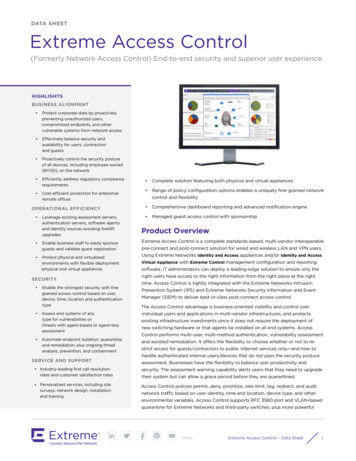
Transcription
Extreme Ownership: How U.S. Navy SEALs Lead and WinNotes by Frumi Rachel Barr, MBA, PhD.Authors: Jocko Willink and Leif BabinPublisher: St. Martin’s PressCopyright year: 2015ISBN: ISBN 978-1-250-06705-0Authors’ Bio: JOCKO WILLINK and LEIF BABIN served as U.S. Navy SEAL officers in SEAL Task UnitBruiser through the Battle of Ramadi, some of the toughest urban combat in the history of the SEALteams. Their task unit remains the most highly decorated special operations unit from the war in Iraq.After returning, Babin and Willink built and led Navy SEAL leadership training for the next generation ofSEALs. Then they took those lessons learned from the battlefield and launched Echelon Front, aleadership consulting firm that teaches others to build and lead their own high-performance winningteams.Authors’ big thought:The book derives its title from the underlying principle— the mind-set— that provides the foundationfor all the rest: Extreme Ownership. Leaders must own everything in their world. There is no one elseto blame.Introduction SEALs, operate as a team of high-caliber, multitalented individuals who have been throughperhaps the toughest military training and most rigorous screening process anywhere. But inthe SEAL program, it is all about the Team. The sum is far greater than the parts.This book describes SEAL combat operations and training through the eyes of the authors, andapplies their experience to leadership and management practices in the business world. Thecombat scenarios describe how they confronted obstacles as a team and overcame theirchallenges together. There can be no leadership where there is no m1
Jocko and Leif wrote this book so that the leadership lessons can continue to impact teamsbeyond the battlefield in all leadership situations— any company, team, or organization inwhich a group of people strives to achieve a goal and accomplish a mission.It is for leaders everywhere to utilize the principles learned to lead and win. Leadershiprequires belief in the mission and unyielding perseverance to achieve victory, particularly whendoubters question whether victory is even possible.The idea for this book was born from the realization that the principles critical to SEAL successon the battlefield— how SEALs train and prepare their leaders, how they mold and develophigh-performance teams, and how they lead in combat— are directly applicable to success inany group, organization, corporation, business, and, to a broader degree, life.This book provides the reader with their formula for success: the mind-set and guidingprinciples that enable SEAL leaders and combat units to achieve extraordinary results. Itdemonstrates how to apply these directly in business and life to likewise achieve victory.The only meaningful measure for a leader is whether the team succeeds or fails. For all thedefinitions, descriptions, and characterizations of leaders, there are only two that matter:effective and ineffective. Effective leaders lead successful teams that accomplish their missionand win. Ineffective leaders do not.For leaders, the humility to admit and own mistakes and develop a plan to overcome them isessential to success. The best leaders are not driven by ego or personal agendas. They aresimply focused on the mission and how best to accomplish it.U.S. military personnel are smart, creative, freethinking individuals— human beings. They mustliterally risk life and limb to accomplish the mission. For this reason, they must believe in thecause for which they are fighting. They must believe in the plan they are asked to execute, andmost important, they must believe in and trust the leader they are asked to follow. This isespecially true in the SEAL Teams, where innovation and input from everyone (including themost junior personnel) are encouraged.Part 1: Winning the War WithinChapter 1: Extreme Ownership On any team, in any organization, all responsibility for success and failure rests with the leader.The leader must own everything in his or her world. There is no one else to blame. The leadermust acknowledge mistakes and admit failures, take ownership of them, and develop a plan towin. The best leaders don’t just take responsibility for their job. They take Extreme Ownershipof everything that impacts their mission. This fundamental core concept enables SEAL leadersto lead high-performing teams in extraordinary circumstances and win.Extreme Ownership isn’t a principle whose application is limited to the battlefield. This conceptis the number-one characteristic of any high-performance winning team, in any military unit,organization, sports team or business team in any industry.If an individual on the team is not performing at the level required for the team to succeed, theleader must train and mentor that underperformer. But if the underperformer continually failsto meet standards, then a leader who exercises Extreme Ownership must be loyal to the teamand the mission above any individual. If underperformers cannot improve, the leader 2
make the tough call to terminate them and hire others who can get the job done. It is all on theleader.Chapter 2: No Bad Teams, Only Bad leaders This is one of the most fundamental and important truths at the heart of Extreme Ownership:there are no bad teams, only bad leaders.This is a difficult and humbling concept for any leader to accept. But it is an essential mind-setto building a high-performance, winning team.When leaders who epitomize Extreme Ownership drive their teams to achieve, a teamperforms well, and performance continues to improve, even when a strong leader istemporarily removed from the team.Every team must have junior leaders ready to step up and temporarily take on roles andresponsibilities for their immediate bosses to carry on the team’s mission and get the job doneif and when the need arises.Leaders should never be satisfied. They must always strive to improve, and they must face thefacts through a realistic, brutally honest assessment of themselves and their team’sperformance.Identifying weaknesses, good leaders seek to strengthen them and come up with a plan toovercome challenges. The best teams are constantly looking to improve, add capability, andpush the standards higher. It starts with the individual and spreads to each of the teammembers until this becomes the culture, the new standard.The recognition that there are no bad teams, only bad leaders facilitates Extreme Ownershipand enables leaders to build high-performance teams that dominate on any battlefield, literalor figurative.Chapter 3: Believe In order to convince and inspire others to follow and accomplish a mission, a leader must be atrue believer in the mission. If a leader does not believe, he or she will not take the risksrequired to overcome the inevitable challenges necessary to win. And they will not be able toconvince others, especially the frontline team who must execute the mission, to do so.Leaders must always operate with the understanding that they are part of something greaterthan themselves and their own personal interests.They must impart this understanding to their teams down to the tactical-level operators on theground. Far more important than training or equipment, a resolute belief in the mission iscritical for any team or organization to win and achieve big results.In many cases the leader must align his thoughts and vision to that of the mission. Actions andwords reflect belief with a clear confidence that is not possible when belief is in doubt.The challenge comes when that alignment isn’t explicitly clear. When a leader’s confidencebreaks, those who are supposed to follow him or her see this and begin to question their ownbelief in the mission.Every leader must be able to detach from the immediate tactical mission and understand how itfits into strategic goals. Leaders must analyze the strategic picture, and then come to aconclusion. If they cannot determine a satisfactory answer themselves, they must ask s.com3
up the chain of command until they understand why. If frontline leaders understand why, theycan move forward, fully believing in what they are doing.The frontline troops never have as clear an understanding of the strategic picture as seniorleaders might anticipate. It is critical that these senior leaders impart a general understandingof that strategic knowledge – the why – to their troops.In any organization, goals must always be in alignment. If goals aren’t aligned at some level, thisissue must be addressed and rectified. In business just as in the military, no senior executiveteam would knowingly choose a course of action or issue an order that would purposely resultin failure. But a subordinate may not understand a certain strategy and thus not believe in it.Junior leaders must ask questions and also provide feedback up the chain so that senior leaderscan fully understand the ramifications of how strategic plans affect execution on the ground.Chapter 4: Check the Ego Ego clouds and disrupts everything: the planning process, the ability to take good advice, andthe ability to accept constructive criticism. It can even stifle someone’s sense of selfpreservation. Often, the most difficult ego to deal with is your own.Everyone has an ego. Ego drives the most successful people in life— in the SEAL Teams, in themilitary, in the business world. They want to win, to be the best. That is good. But when egoclouds our judgment and prevents us from seeing the world as it is, then ego becomesdestructive.When personal agendas become more important than the team and the overarching mission’ssuccess, performance suffers and failure ensues. Many of the disruptive issues that arise withinany team can be attributed directly to a problem with ego.Implementing Extreme Ownership requires checking your ego and operating with a high degreeof humility. Admitting mistakes, taking ownership, and developing a plan to overcomechallenges are integral to any successful team.Ego can prevent a leader from conducting an honest, realistic assessment of his or her ownperformance and the performance of the team.Part 11: Laws of CombatChapter 5: Cover and Move Cover and Move: it is the most fundamental tactic, perhaps the only tactic. Put simply, Coverand Move means teamwork.All elements within the greater team are crucial and must work together to accomplish themission, mutually supporting one another for that singular purpose.Departments and groups within the team must break down silos, depend on each other andunderstand who depends on them. If they forsake this principle and operate independently orwork against each other, the results can be catastrophic to the overall team’s performance.Within any team, there are divisions that arise. Often, when smaller teams within the team getso focused on their immediate tasks, they forget about what others are doing or how theydepend on other teams. They may start to compete with one another, and when there areobstacles, animosity and blame develops. This creates friction that inhibits the overall 100mustreads.com4
It falls on leaders to continually keep perspective on the strategic mission and remind the teamthat they are part of the greater team and the strategic mission is paramount. Each member ofthe team is critical to success, though the main effort and supporting efforts must be clearlyidentified.If the overall team fails, everyone fails, even if a specific member or an element within the teamdid their job successfully. Pointing fingers and placing blame on others contributes to furtherdissension between teams and individuals. These individuals and teams must instead find a wayto work together, communicate with each other, and mutually support one another.The focus must always be on how to best accomplish the mission. Alternatively, when the teamsucceeds, everyone within and supporting that team succeeds. Every individual and every teamwithin the larger team gets to share in the success.Accomplishing the strategic mission is the highest priority. Team members, departments, andsupporting assets must always Cover and Move— help each other, work together, and supporteach other to win. This principle is integral for any team to achieve victory.Chapter 6: Simple Combat, like anything in life, has inherent layers of complexities. Simplifying as much aspossible is crucial to success.When plans and orders are too complicated, people may not understand them. And whenthings go wrong, and they inevitably do go wrong, complexity compounds issues that can spiralout of control into total disaster.Plans and orders must be communicated in a manner that is simple, clear, and concise.Everyone that is part of the mission must know and understand his or her role in the missionand what to do in the event of likely contingencies.As a leader, it doesn’t matter how well you feel you have presented the information orcommunicated an order, plan, tactic, or strategy. If your team doesn’t get it, you have not keptthings simple and you have failed. You must brief to ensure the lowest common denominatoron the team understands.It is critical, as well, that the operating relationship facilitate the ability of the frontline troops toask questions that clarify when they do not understand the mission or key tasks to beperformed. Leaders must encourage this communication and take the time to explain so thatevery member of the team understands.Simple: this principle isn’t limited to the battlefield. In the business world, and in life, there areinherent complexities. It is critical to keep plans and communication simple. Following this ruleis crucial to the success of any team in any combat, business or life.Chapter 7: Prioritize and Execute On the battlefield, countless problems compound in a snowball effect, every challenge complexin its own right, each demanding attention. But a leader must remain calm and make the bestdecisions possible. To do this, SEAL combat leaders utilize Prioritize and Execute.This principle is verbalized with this direction: “Relax, look around, make a call.” Even the mostcompetent of leaders can be overwhelmed if they try to tackle multiple problems or a numberof tasks simultaneously. The team will likely fail at each of those om5
Instead, leaders must determine the highest priority task and execute. When overwhelmed,fall back upon this principle: Prioritize and Execute.Multiple problems and high-pressure, high-stakes environments occur in many facets of life andparticularly in business. Business decisions may lack the immediacy of life and death, but thepressures on business leaders are still intense. The success or failure of the team, thedepartment, the company, the financial capital of investors, careers, and livelihoods are atstake. These pressures produce stress and demand decisions that often require rapid execution.Such decision making for leaders can be overwhelming.A particularly effective means to help Prioritize and Execute under pressure is to stay at least astep or two ahead of real-time problems. Through careful contingency planning, a leader cananticipate likely challenges that could arise during execution and map out an effective responseto those challenges before they happen. That leader and his or her team are far more likely towin.Staying ahead of the curve prevents a leader from being overwhelmed when pressure is appliedand enables greater decisiveness. If the team has been briefed and understands what actions totake through such likely contingencies, the team can then rapidly reprioritize efforts and rapidlyadapt to a constantly changing battlefield.To implement Prioritize and Execute in any business, team, or organization, a leader must: evaluate the highest priority problem. lay out in simple, clear, and concise terms the highest priority effort for your team. develop and determine a solution, seek input from key leaders and from the teamwhere possible. direct the execution of that solution, focusing all efforts and resources toward thispriority task. move on to the next highest priority problem. Repeat. when priorities shift within the team, pass situational awareness both up and down thechain. don’t let the focus on one priority cause target fixation. Maintain the ability to see otherproblems developing and rapidly shift as needed.Chapter 8: Decentralized Command Human beings are generally not capable of managing more than six to ten people, particularlywhen things go sideways and inevitable contingencies arise.Teams must be broken down into manageable elements of four to five operators, with a clearlydesignated leader. Those leaders must understand the overall mission, and the ultimate goal ofthat mission.Junior leaders must be empowered to make decisions on key tasks necessary to accomplishthat mission in the most effective and efficient manner possible.Teams within teams are organized for maximum effectiveness for a particular mission, withleaders who have clearly delineated responsibilities.Every tactical-level team leader must understand not just what to do but why they are doing it.If frontline leaders do not understand why, they must ask their boss to clarify the why.Decentralized Command does not mean junior leaders or team members operate on their ownprogram; that results in chaos. Instead, junior leaders must fully understand what is within m6
decision-making authority— the “left and right limits” of their responsibility. Additionally, theymust communicate with senior leaders to recommend decisions outside their authority andpass critical information up the chain so the senior leadership can make informed strategicdecisions.Junior leaders must be proactive rather than reactive.To be effectively empowered to make decisions, it is imperative that frontline leaders executewith confidence. Tactical leaders must be confident that they clearly understand the strategicmission and the Intent. They must have implicit trust that their senior leaders will back theirdecisions. Without this trust, junior leaders cannot confidently execute, which means theycannot exercise effective Decentralized Command.To ensure this is the case, senior leaders must constantly communicate and push information totheir subordinate leaders. Likewise, junior leaders must push situational awareness up thechain to their senior leaders to keep them informed, particularly of crucial information thataffects strategic decision making.There are leaders who try to take on too much themselves. When this occurs, operations canquickly dissolve into chaos. The fix is to empower frontline leaders through DecentralizedCommand and ensure they are running their teams to support the overall mission, withoutmicromanagement from the top.There are, likewise, other senior leaders who are so far removed from the troops executing onthe frontline that they become ineffective. These leaders might give the appearance of control,but they actually have no idea what their troops are doing and cannot effectively direct theirteams. SEAL teams call this trait “battlefield aloofness.” This attitude creates a significantdisconnect between leadership and the troops, and such a leader’s team will struggle toeffectively accomplish their mission.Determining how much leaders should be involved and where leaders can best positionthemselves to command and control the team is key.Contrary to a common misconception, leaders are not stuck in any particular position. Leadersmust be free to move to where they are most needed, which changes throughout the course ofan operation.Understanding proper positioning as a leader is a key component of effective DecentralizedCommand. Effectiveness of Decentralized Command is critical to the success of any team in anyindustry. In chaotic, dynamic, and rapidly changing environments, leaders at all levels must beempowered to make decisions. Decentralized Command is a key component to victory.Chapter 9: Plan What’s the mission? Planning begins with mission analysis. Leaders must identify cleardirectives for the team. Once they themselves understand the mission, they can impart thisknowledge to their key leaders and frontline troops tasked with executing the mission.A broad and ambiguous mission results in lack of focus, ineffective execution, and missioncreep. To prevent this, the mission must be carefully refined and simplified so that it is explicitlyclear and specifically focused to achieve the greater strategic vision for which that mission is apart.The mission must explain the overall purpose and desired result, or “end state,” of theoperation. The frontline troops tasked with executing the mission must understand the om7
purpose behind the mission. A simple statement, the Commander’s Intent, is actually the mostimportant part of the brief. When understood by everyone involved in the execution of theplan, it guides each decision and action on the ground.Different courses of action must be explored on how best to accomplish the mission— with themanpower, resources, and supporting assets available. Once a course of action is determined,further planning requires detailed information gathering in order to facilitate the developmentof a thorough plan. It is critical to utilize all assets and lean on the expertise of those in the bestposition to provide the most accurate and up-to-date information.Leaders must delegate the planning process down the chain as much as possible to keysubordinate leaders. Team leaders within the greater team and frontline, tactical level leadersmust have ownership of their tasks within the overall plan and mission.Team participation— even from the most junior personnel— is critical in developing bold,innovative solutions to problem sets. Giving the frontline troops ownership of even a smallpiece of the plan gives them buy-in, helps them understand the reasons behind the plan, andbetter enables them to believe in the mission, which translates to far more effectiveimplementation and execution on the ground.While the senior leader supervises the entire planning process by team members, he or shemust be careful not to get bogged down in the details. By maintaining a perspective above themicro-terrain of the plan, the senior leader can better ensure compliance with strategicobjectives. Doing so enables senior leaders to “stand back and be the tactical genius”— toidentify weaknesses or holes in the plan that those immersed in the details might have missed.This enables leaders to fill in those gaps before execution.Once the detailed plan has been developed, it must then be briefed to the entire team and allparticipants and supporting elements. Leaders must carefully prioritize the information to bepresented in as simple, clear, and concise a format as possible so that participants do notexperience information overload.The planning process and briefing must be a forum that encourages discussion, questions, andclarification from even the most junior personnel. If frontline troops are unclear about the planand yet are too intimidated to ask questions, the team’s ability to effectively execute the planradically decreases. Thus, leaders must ask questions of their troops, encourage interaction,and ensure their teams understand the plan.Following a successful brief, all members participating in an operation will understand thestrategic mission, the Commander’s Intent, the specific mission of the team, and their individualroles within that mission. They will understand contingencies— likely challenges that mightarise and how to respond.The test for a successful brief is simple: Do the team and the supporting elements understandit?The plan must mitigate identified risks where possible. SEALs are known for taking significantrisk, but in reality SEALs calculate risk very carefully. A good plan must enable the highestchance of mission success while mitigating as much risk as possible.There are some risks that simply cannot be mitigated, and leaders must instead focus on thoserisks that actually can be ads.com8
Detailed contingency plans help manage risk because everyone involved in the direct execution(or in support) of the operation understands what to do when obstacles arise or things gowrong. Leaders must be comfortable accepting some level of risk.The best teams employ constant analysis of their tactics and measure their effectiveness sothat they can adapt their methods and implement lessons learned for future missions. Oftenbusiness teams claim there isn’t time for such analysis. But one must make time. The best SEALunits, after each combat operation, conduct what we called a “post-operational debrief.” Nomatter how exhausted from an operation or how busy planning for the next mission, time ismade for this debrief because lives and future mission success depend on it.A post-operational debrief examines all phases of an operation from planning throughexecution, in a concise format. It addresses the following for the combat mission justcompleted: What went right? What went wrong? How can we adapt our tactics to make useven more effective and increase our advantage over the enemy?It is critical for the success of any team in business to do the same and implement thosechanges into their future plans so that they don’t repeat the same mistakes.While businesses can have their own planning process, it must be standardized so that otherdepartments within the company and supporting assets outside the company (such as servicecontractors or subsidiary companies) can understand and use the same format andterminology. It must be repeatable and guide users with a checklist of all the important thingsthey need to think about. The plan must be briefed to the participants, geared toward thefrontline troops charged with execution so they clearly understand it. Implementing such aplanning process will ensure the highest level of performance and give the team the greatestchance to accomplish the mission and win.A leader’s checklist for planning should include the following: Analyze the mission. Understand the mission, intent and end-state (the goal). Identify and state your own Commander’s Intent and end-state for the specific mission. Identify personnel, assets, resources, and time available. Decentralize the planning process. —Empower key leaders within the team to analyzepossible courses of action. Determine a specific course of action. —Lean toward selecting the simplest course ofaction. —Focus efforts on the best course of action. Empower key leaders to develop the plan for the selected course of action. Plan forlikely contingencies through each phase of the operation. Mitigate risks that can be controlled as much as possible. Delegate portions of the plan and brief to key junior leaders. —Stand back and be thetactical genius. Continually check and question the plan against emerging information to ensure it stillfits the situation. Brief the plan to all participants and supporting assets. —Emphasize Commander’sIntent. —Ask questions and engage in discussion and interaction with the team toensure they understand. Conduct post-operational debrief after execution. —Analyze lessons learned andimplement them in future s.com9
Chapter 10. Leading Up and Down the Chain of CommandLEADING DOWN THE CHAIN Any good leader is immersed in the planning and execution of tasks, projects, and operations tomove the team toward a strategic goal. Such leaders possess insight into the bigger picture andwhy specific tasks need to be accomplished. This information does not automatically translate to subordinate leaders and the frontlinetroops. Junior members of the team— the tactical level operators— are rightly focused on their specificjobs. They must be in order to accomplish the tactical mission. They do not need the fullknowledge and insight of their senior leaders, nor do the senior leaders need the intricateunderstanding of the tactical level operators’ jobs. Still, it is critical that each have anunderstanding of the other’s role. It is paramount that senior leaders explain to their junior leaders and troops executing themission how their role contributes to big picture success. This is not intuitive and never asobvious to the rank-and-file employees as leaders might assume. Leaders must routinely communicate with their team members to help them understand theirrole in the overall mission. Frontline leaders and troops can then connect the dots betweenwhat they do every day— the day-to-day operations— and how that impacts the company’sstrategic goals. This understanding helps the team members prioritize their efforts in a rapidlychanging, dynamic environment. That is leading down the chain of command. It requiresregularly stepping out of the office and personally engaging in face-to-face conversations withdirect reports and observing the frontline troops in action to understand their particularchallenges and read them into the Commander’s intent. This enables the team to understandwhy they are doing what they are doing, which facilitates Decentralized Command. As a leader employing Extreme Ownership, if your team isn’t doing what you need them to do,you first have to look at yourself. Rather than blame them for not seeing the strategic picture,you must figure out a way to better communicate it to them in terms that are simple, clear, andconcise, so that they understand. This is what leading down the chain of
Extreme Ownership isn’t a principle whose application is limited to the battlefield. This concept is the number-one characteristic of any high-performance winning team, in any military unit, organization, sports team or business team in any industry.File Size: 642KB











